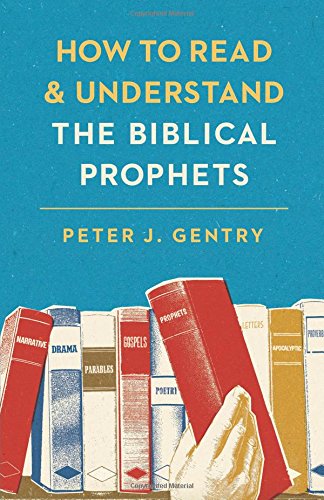Reviewed by Theresa White
Christians are often intimidated by the genre of biblical prophecy. They may find these sections of the Bible confusing, draw wrong conclusions, or determine that it is better to leave these texts to the experts. Peter J. Gentry is a professor of Old Testament interpretation at the Southern Baptist Theological Seminary who wants to make the prophetic books accessible for the Christian reader. His small book How to Read & Understand the Biblical Prophets addresses why people often find these texts difficult, discusses seven specific sticking points where typical readers today fail to understand what the text is doing, and aims to show people how to apply their new knowledge to read the text themselves.
Gentry first identifies conventions of Hebrew literature, and the prophetic literature more specifically, that must be understood and respected. These “ancient” and “Eastern” characteristics seem foreign to those of us who are “modern” and “Western” (16), but we can learn to adapt to them just like we adapt naturally to different genres when we read the newspaper. After this reassuring introduction, Gentry identifies and explores in detail the seven main features of biblical prophecy that contemporary readers must understand:
- Its most common emphasis is to expose covenant disloyalty in order to call God’s people back to him.
- It records future events to prove the power of God to know and control the future, to explain for future generations and distant peoples the spiritual reasons underlying events, to acknowledge that fulfillment of some prophecies would span multiple generations, and to show God’s faithfulness to his word.
- It shares the repetitive patterns common in Hebrew literature (including word pairs, parallel lines in poetry, and chiasm of large units of text), calling readers to learn from the stereo effect of multiple perspectives on the same things.
- It records speeches about foreign nations in fulfillment of God’s covenant promise to execute justice upon the enemies of God’s people as the counterpoint to his restoration of the world.
- It uses allusions to previous Scripture and typological images from the past as models for describing God’s work in the future.
- It sometimes uses apocalyptic metaphors and symbols to paint a picture of future and spiritual realities.
- It often describes events from different points in the future as if they happen at the same time, flattening the chronological depth-perception.
After describing how to read the biblical prophets responsibly as Hebrew literature, Gentry concludes with the implications that this has for eschatological discussions rooted in prophetic texts. The appendix applies these insights to a reading of Revelation as Hebrew prophecy that employs many of the same conventions taught in the chapters of this book, relying heavily on the preceding discussion of repetition, typology, and apocalyptic language.
Gentry’s book aims to be very accessible for average laypersons interested in learning how to read the Bible better for themselves. It helpfully engages such readers, recognizing their potential reluctance to venture into the biblical prophets and promising to clarify exactly how to move forward. Unfamiliar words are defined, and illustrations from daily life show how navigating the unfamiliar world of Hebrew literature does not need to be intimidating. That said, occasional organizational issues like using terms long before defining them, failure to consistently mark verses of quoted texts for ease of referencing, and repetitive illustrations and definitions make the text harder to use than it intends to be and require extra perseverance from the reader. Nevertheless, the text does a good job of identifying the big points essential for understanding Hebrew prophecy, especially prophecy’s connection to covenant relationship with God, deliberately non-literal imagery, Hebrew penchant for repetition, and other common sources of confusion for the uninformed reader. Gentry’s illumination of these common areas of misunderstanding goes a long way toward enabling Christian readers to interpret the biblical prophets in a way that is faithful to their genre and ancient context, and thus to their authors’ intentions. Readers who understand the concepts taught in this book will surely be much better equipped with the tools to read and understand biblical prophecy.
Although the book provides the conceptual tools for understanding biblical prophecy, one of its weaknesses undermines its intention to teach readers how to use those tools to interpret particular texts. Gentry admirably takes readers to Scripture for examples of the features it discusses, but it is not always evident to readers how he uses a given characteristic of prophecy to arrive at the stated conclusions about a passage’s meaning. It feels like the reader is still missing a piece that would allow him or her to know to apply the concept in that way to that passage. One factor contributing to this problem is that Gentry’s interpretive framework is shaped by his unique integration of covenant theology and dispensationalism, which remains unstated in this text and leads to confusion for readers unaware of his underlying presupposition. In other cases, the missing piece is harder to identify, leaving readers unsure how Gentry gets from the biblical text to the stated meaning using the tools discussed, much less how they can confidently replicate that route to right understanding on their own.
The early part of the book cautions that readers are unable to rightly understand biblical prophecy without mastering the seven concepts this book will teach them. In many ways this is correct, and understanding the concepts Gentry explains does allow readers to come away with some of the most important tools to avoid common pitfalls in reading biblical prophecy. However, some readers could leave the book further discouraged by these warnings when some of the examples prove hard to follow. The key for such readers will be learning to exercise this new understanding in their own practice as they read the biblical prophets and discover the significant insights they can gain.
Theresa White is an MDiv student at Trinity Evangelical Divinity School.
